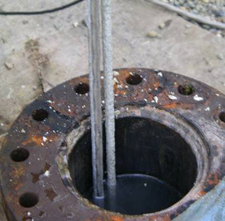|
Besides receiving NSC support, this large scale, trans-national drilling project also received assistance from the International Continental Drilling Project (ICDP). By being listed in the ICDP global earth science drilling group, this project was qualified to receive a drilling process internet upload system and core sample scanner from ICDP headquarters in Germany. The US Geologic Survey also provided much technology and personnel training assistance. After core samples were extracted on site, the team immediately conducted internet uploads, core scans, descriptions, photos, and sealed sample crates; at the same time and also on site, they conducted gas analysis, liquid analysis, temperature measurement and stress measurement. They even stored a small section of core in a vacuum specimen box to be used in future microbial analysis work. When the core analysis was completed, everything was sent back to Taiwan to be stored securely at the NTU Department of Geosciences.
|
|
Another important part of this research work was using an electron microscope to observe and analyze the fine grain particles in the fault clay to calculate how much energy, how much friction heat was produced, how many chemical reactions occurred in the gouge, etc. The study discovered that the Chi-Chi earthquake energy reached 11.6 X 106 J/m2. Only 6% of this energy triggered the slip and conducted the rupture's seismic activity; the rest of the energy led to other reactions, including heat and release of shock waves. Clay mineral analysis revealed that, at the time of the earthquake, the temperature rose in excess of 1,100 degrees Celsius, making the fault zone gouge melting and form pseudotachylyte and fault clay, thus increasing permeability by a magnitude of 1 to 2. These results indicate the possibility that triggering a rapid increase in heat leads to the phenomenon of intense thermal pressurization, which rapidly weakens the fault zone and leads to gigantic seismic rupture activity.
The research team at the same time discovered that seismic activity could occur again at the Chelungpu-fault. In other words, the occurrence of earthquakes is repeatable; all major earthquakes carry the possibility of recurring. For this reason, it is of the utmost importance to strengthen and expand research about earthquake faults, to establish an earthquake warning system, to avoid building bridges, major public constructions or high-rise buildings in the vicinity of fault zones, so we might hope to reduce the damage of earthquake disasters to the minimum.
|
After the drilling, the research team measures the temperature in the shaft.
In the above illustration, the bottom half shows Chi-Chi earthquake fault clay. The upper half shows the research team using an electron microscope to observe the simulation result of the earthquake fault zone. Collating results, it was discovered that the temperature of the Chi-Chi earthquake fault zone may have reached 1,100 degrees Celsius.
|



